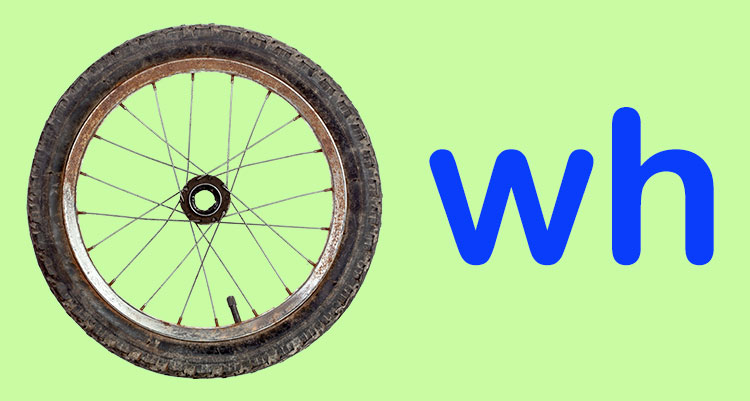I 2: Touch & Tell: wh and ng
1. Overview
Introduce your child to the idea that some sounds have two letters. When those two letter sounds are put together, they make a new sound. The special sound wh only occurs at the beginning of a word, but the special sound ng only occurs at the end of a word.
I2: Touch & Tell: wh and ng
2. Materials
- Script
- word list (same as for previous activity)
- sound cards for the digraphs (same as for previous activity)
3. Activity
Video: How to play Touch & Tell: wh and ng
Show your child the wh and ng sound cards. Remind her that the sound pictures (letters) on these cards are best friends. They stick together and say a new sound. Say that the new sounds are easy to learn because of the clues you will show her.
Tell your child that /wh/ is kind of a windy sound. Puff out your cheeks while showing her the /wh/ sound card. Go through the /wh/ words in the same way as before, having the child repeat the word and point to the /wh/ card each time. Be sure to point out that the /wh/ sound always occurs at the beginning of the word.
Adult: Here’s a new special sound: /wh/. [Show /wh/ card.] It’s a windy sound—puff out your cheeks and blow like the wind! [Demonstrate the gesture with child copying you.] This /wh/ sound only happens at the beginning of words. Now I’m going to say some words with a /wh/ sound in them. You listen, then point to the /wh/ card and repeat my word. Ready: Wheel. [Point to /wh/ card and puff out cheeks and blow.] Your turn. Child: [pointing to /wh/ card and making blowing wind gesture] Wheel. Adult: Good. Here’s another word: whip.Now show her the /ng/ sound card. Tell her that this sound will make her nose buzz a little. Put your forefinger lightly against one side of your nose and say ring. Have the child follow your example. Then go through the /ng/ words in the provided word list. Explain to the child that all /ng/ sounds (in one-syllable words) occur at the end of the word.
Adult: Here’s one more sound: /ng/. [Show /ng/ card.] This is a fun sound because it makes your nose buzz a little! Put your finger on the side of your nose and say ring, like this: [Say ring and demonstrate the gesture with child copying you.] Did you feel your nose buzz? Child: Yeah! Adult: Good! This /ng/ sound only happens at the end of words. Now I’m going to say some words with this /ng/ sound in them. You listen, then point to the /ng/ card and repeat my word. Put one finger on your nose so you can feel it buzz. Ready: Bang. [Point to /ng/ card with one forefinger and put other forefinger on side of nose.] Your turn. Child: [pointing to /ng/ card and putting other finger on nose] Bang. Adult: Good. Here’s another word: king.Go through 10-12 /wh/ and /ng/ words for the child to repeat and match to the correct sound and sound card. Use the blowing gesture or put your finger on the side of your nose for each word. Encourage the child to do the same. When the child is able to identify these two sounds consistently, display the other three digraph sound cards. Now mix in some of the /ch/, /th/, and /sh/ words from the previous activity. Go through this mix of words, in random order, until the child is confident in her responses. ↑ Top
4. Small Groups (2-5 children)
Lesson Objective: Using digraph picture cards as visual aids, children will recognize the wh and ng digraphs in isolation and verbally match them with their corresponding phonemes. GELDS (Georgia Early Learning & Development Standards): CLL6.4f Georgia Standards of Excellence: ELAGSEKRF3.a Common Core State Standards: CCSS.ELA-LITERACY.RF.K.3.A Additional Materials: one set of digraph sound cards for each child in the group Adaptation: Read the main activity, watch the video, and follow the instructions above, with the following changes: Warm up by reviewing the /ch/, /sh/, and /th/ sounds. Divide this activity into three lessons.- Introduce the /wh/ “windy” sound. It only appears at the beginning of words. Give each child a /wh/ sound card, and call words from the word list. The children should touch the sound card and repeat each word. Provide many opportunities for practice.
- Review /wh/, and introduce /ng/. This sound can make your nose buzz a little. Have the children practice. This sound only comes at the end of a word. Give each child a /ng/ sound card, and tell them to touch the /ng/ as you say words from the word list.
- Review /wh/ and /ng/. Give each child an /ng/ and /wh/ sound card. Call random words from the list, and tell the children to touch the correct sound the word begins or ends with.
Leave a Reply

